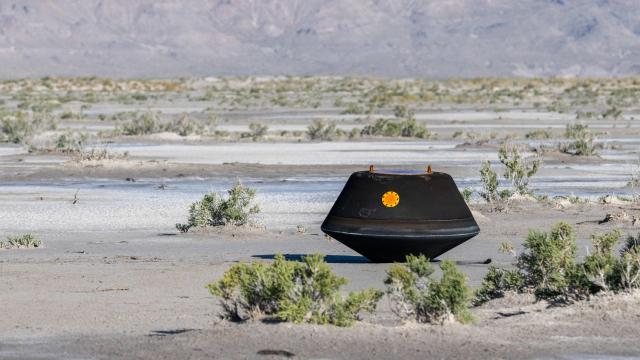Earth just got a special delivery: Pieces of an ancient asteroid that were snagged straight from the source and dropped off in the western Utah desert. After travelling through space for nearly three years, the journey is just beginning for the precious rock samples, which could help scientists figure out the story of life.
On Sunday, NASA’s OSIRIS-REx dropped off a capsule of rocks and dust collected from asteroid Bennu at the Department of Defense’s Utah Test and Training Range near Salt Lake City. The collected pieces from the asteroid are being prepped to undergo extensive analysis by scientists around the world, all aiming to better understand the origin of organics and water that led to life on Earth. Bennu is also a near-Earth potentially hazardous asteroid, therefore studying it closely can help us learn more about its potential threats to our planet.
Following its parachute-assisted landing at 10:52 a.m. ET, a helicopter carried the sample capsule in a cargo net to a temporary clean room where it was connected to a continuous flow of nitrogen. The nitrogen purge, as scientists call it, is meant to prevent Earthly contaminants from entering the canister containing pieces of Bennu so that the asteroid sample remains pure for scientific analysis.
On Monday, the Bennu sample, an estimated 8.8 ounces of asteroid rock and dust (250 grams), will be transported in its unopened canister to NASA’s Johnson Space Center in Houston by aircraft. There, scientists will finally open the canister, extract and weigh the sample, create an inventory of what’s inside, and distribute pieces of Bennu to teams of scientists around the world, according to NASA.
Bennu is a small, near-Earth asteroid that makes a close pass to Earth every six years or so. Scientists believe Bennu might have broken off from a much larger carbon-rich asteroid about 700 million to 2 billion years ago, and drifted much closer to Earth since then.
“Successfully delivering samples from Bennu to Earth is a triumph of collaborative ingenuity and a testament to what we can accomplish when we unite with a common purpose. But let’s not forget—while this may feel like the end of an incredible chapter, it’s truly just the beginning of another,” Dante Lauretta, principal investigator for OSIRIS-REx at the University of Arizona, Tucson, said in a statement. “We now have the unprecedented opportunity to analyze these samples and delve deeper into the secrets of our solar system.”
The OSIRIS-REx mission launched in September 2016 and reached asteroid Bennu in December 2018. After nearly two years of observations, the spacecraft landed on Bennu and snagged a sample from its surface in October 2020. On May 10, 2021, OSIRIS-REx said goodbye to Bennu and began its journey back home to drop off its precious cargo.
The spacecraft was 63,000 miles (102,000 kilometres) away from Earth’s surface when it released its sample capsule toward Earth’s atmosphere at 6:42 a.m. ET, according to NASA. After dropping off its sample, the OSIRIS-REx spacecraft began making its way towards its next mission of exploring asteroid Apophis. Accordingly, the mission will be renamed to OSIRIS-APEX (OSIRIS-Apophis Explorer).
The sample capsule made its way down at speed of 27,650 miles per hour (44,500 kilometers per hour), and it pierced the atmosphere at 10:42 a.m. ET off the coast of California at an altitude of about 83 miles (133 kilometres). Around 10 minutes later, the capsule landed in the Utah desert with the help of two parachutes to slow it down.
“The whole team had butterflies today, but that’s the focused anticipation of a critical event by a well-prepared team,” Rich Burns, project manager for OSIRIS-REx at NASA’s Goddard Space Flight Center, said in a statement. “For us, this was the World Series, ninth inning, bases-loaded moment, and this team knocked it out of the park.”
Related article: Samples From Asteroid Suggest Space Rocks Brought Ingredients for Life to Earth
This marks the first time that NASA has returned surface samples from an asteroid. Japan achieved the same feat in December 2020, returning samples of asteroid Ryugu as part of the Hayabusa2 mission.
For more spaceflight in your life, follow us on Twitter and bookmark Gizmodo’s dedicated Spaceflight page.
